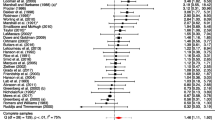Abstract
The best predictor of sexual offense recidivism is believed to be past sexual offending. However, clinical observations of treated individuals often contradict this view. Consequently, this relationship was evaluated, using a minimum follow-up period of 18 months. The samples were adult men and consisted of 127 treatment noncompleters who terminated treatment because of inadequate motivation/unacceptable behavior, legal transfer, or by request and 150 treatment completers who underwent a minimum of 6 months of 32–35 hours per week of therapy. Sexual offense conviction recidivism and prior sexual offense convictions were significantly related in noncompleters ( r =.31, p < .05) but were not significantly related in completers (r = .03, p > .05). These two correlations differed significantly (two-tailed p < .05). There was no difference (p > .05) in the average number of prior sexual offense convictions between completers and noncompleters. The findings are supportive of treatment interventions, although they question the validity of prior sexual offenses in treated offenders for release decisions and/or risk prediction.
Similar content being viewed by others
REFERENCES
Hall, G. C. N. (1988). Criminal behavior as a function of clinical and actuarial variables in a sexual offender population. Journal of Consulting and Clinical Psychology, 56, 773-775.
Hall, G. C. N., & Proctor, W. C. (1987). Criminological predictors of recidivism in a sexual offender population. Journal of Consulting and Clinical Psychology, 55, 111-112.
Hanson, R. K., & Bussière, M. T. (1996). Predictors of sexual offender recidivism: A meta-analysis (User Report, Cat. No. JS4-1/1996-4E). Ottawa, Ontario: Ministry Secretariat, Solicitor General of Canada.
MacLennan, R. N. (1988). Correlation, base-rates, and the predictability of behavior. Personality and Individual Differences, 9, 675-684.
Maletzky, B. M. (1993). Factors associated with success and failure in the behavioral and cognitive treatment of sexual offenders. Annals of Sex Research, 6, 241-258.
Quinsey, V. (1990). Sexual violence. In R. Bluglass & P. Bowden (Eds.), Principles and practice of forensic psychiatry (pp. 563-570). Edinburgh: Churchill Livingstone.
Proulx, J., Pellerin, B., Paradis, Y., McKibben, A., Aubut, J., & Ouimet, M. (1997). Static and dynamic predictors of recidivism in sexual aggressors. Sexual Abuse: A Journal of Research and Treatment, 9, 7-27.
Statistics Canada. (1993) An examination of recidivism in relation to offence histories and offender profiles. Ottawa, Ontario: Statistics Canada, Canadian Centre for Justice Statistics.
Studer, L. H., Reddon, J. R., Roper, V., & Estrada, L. (1996). Phoenix: An inhospital treatment program for sex offenders. Journal of Offender Rehabilitation, 23, 91-97.
Author information
Authors and Affiliations
Rights and permissions
About this article
Cite this article
Studer, L.H., Reddon, J.R. Treatment May Change Risk Prediction for Sexual Offenders. Sex Abuse 10, 175–181 (1998). https://doi.org/10.1023/A:1021361703167
Issue Date:
DOI: https://doi.org/10.1023/A:1021361703167




